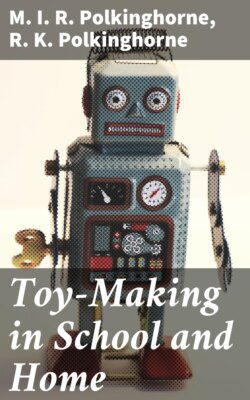Читать книгу Toy-Making in School and Home - R. K. Polkinghorne - Страница 11
На сайте Литреса книга снята с продажи.
CHAPTER IV
MORE PAPER TOYS
ОглавлениеTable of Contents
Fig. 42
Fig. 43
A Bridge (Fig. 42). Begin with square (8 inches each side), fold in four and cut off one piece. Fold again in four, folds running in opposite directions to first folds, and cut off one piece. A square, A B C D, remains, divided into nine squares (Fig. 43). Fold A G and F C in halves, cut off shaded portions. Join L E, F N, M Gand H O, and cut off shaded portions. Cut along L R, N S, M P and O Q; bend as in Fig. 42. Matches can be gummed on the slopes of the bridge. If a piece of white cardboard or paper is placed underneath a river can be marked on it and paper boats made.
Fig. 44
Fig. 45
The children can make a very pretty scene from this. Trees can be coloured and cut out of paper and gummed upright by means of a little flap of paper left at the end of the trunk of the tree. The house can be cut out of a piece of folded paper (Fig. 44) so that it will stand; animals can be cut in a similar way (Fig. 45). Boats are made of plasticine, with paper sails stuck in it. Children can add other animals and think of other additions to the scene.
Fig. 46
Fig. 47
Fig. 48
A Punt (Fig. 46). Begin with a square, fold into sixteen parts, cut off a quarter. Fold in half oblongs A B and C D (Fig. 47). Cut off the shaded portions. Cut along the lines M E, C N, O B, P G. Fold along M K, F N, O L and P H. The child will accomplish this fold more easily if she puts her ruler along a line from K to M and folds the paper over it. A coloured band should be chalked round the punt. To fasten it together gum K E M to M E C N, C N F to M E C N and so on the other side. Three seats are fastened inside, made from the quarter cut off the original square. The length of the seat is equal to the distance E C; the height of the seat to half of the distance K E (Fig. 48).
The punt should be made from a square of cartridge paper, eleven inches each side. It will be found to float well on water.
Fig. 49
Fig. 50
A Candlestick (Fig. 49). Begin with two squares of coloured paper (sides 4 inches); one forms the bottom of the candlestick; half the other forms the socket. To make the socket fold and cut as in Fig. 50. The other half divided lengthways forms the handle. The handle and socket can be fastened on with paper-fasteners or gummed. It looks neater when gummed. A roll of yellow paper or white paper coloured forms the candle; into this roll some cotton-wool is put and into this a piece of red paper for the flame. Children delight in making candlesticks of different colours and decorating their form rooms with them. The candlestick can be strengthened by being gummed on to a piece of cardboard (a post-card will do). A round candlestick can be made in a similar way.
To make the socket, fold the oblong (Fig. 50) into four parts, leaving a piece, E, over; gum E to A.
A Lantern. Begin with an oblong 8 inches by 5½ inches, A B C D (Fig. 51). Fold along E T K and G H to get flanges. Fold C A B D into half to obtain the line L M, and fold A L M B into four parts to obtain the line L´ M´. Fold A H C G into four parts along Q P, O N and S R. Draw the top of the lantern in A H L´ M´, as in Fig. 51, and cut off the shaded portion. Draw or cut windows in the sides of the lantern. Cut the flange abc as in the diagram. Make the candle and the candlestick to fit into the lantern as in Fig. 49. (Note the length of the edge of the candlestick is the width of the lantern E T.) Bend the flanges a, b, c at right angles to the sides and gum the candlestick to these. Flange d can be gummed to the edge L´ E, and a door cut in one of the sides, or flange d can be cut off and then side l forms the door. Make holes in the tops of the lantern and tie together with thread, as in Fig. 52, or the flanges can be left round the triangular tops and they can be gummed together. Fig. 52 shows the finished model.
